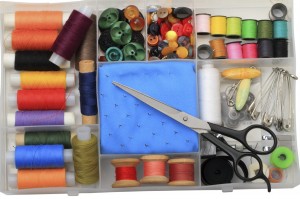Sewing is a hobby that offers many benefits. You may even be lucky enough to do it for a little extra income. Making clothing for kids, treasured blankets for friends, or just creating various gifts for friends and family, the possibilities sewing offers are endless. But so is the mess that comes with the tools and materials for each project.
If you feel that the disorganized chaos of your sewing room could use a makeover, consider the following suggestions.
The Most Functional Work Space
“A work surface that has a large top allows plenty of space to cut, piece, and iron,” writes an author on AllPeopleQuilt.com, the website for several popular quilting magazines. “Storage nooks on the front and back of the work surface can showcase pretty crafts supplies, books, and fabric.” You can use everything from a large craft table purchased in a craft store to a counter-top high table with crates stacked under it for storage cubbies.
Any typical desk will function well for your sewing machine. Pull it away from the wall in order to feed larger projects, such as quilts, effectively over the sewing machine without a lot of bunching, which can dishevel your piecing and pattern.
If your sewing room is more of a sewing corner, don’t fret. Consider using an L-shaped desk so you have a place for your sewing machine and a functional workspace. Or, if space is really limited, store all of you sewing supplies, including the machine, in an armoire or hutch. Then pull out a folding table to work when you need to (which is easily put away when company arrives).
“A handy pullout shelf in the lower compartment of a cabinet makes a sewing machine and supplies accessible, but out of sight,” advises AllPeopleQuit.com. “Stacked white bins and removable hooks on the back of the cabinet door further maximize the interior space.”
Where to Store the Fabric
One great way to store fabric is in an unused or refurbished chest of drawers (or two, depending on how much fabric you have). Fold the fabric ream-style and, instead of stacking the reams, lay the fabric vertically in the drawers so that you can easily see all the colors and designs. In fact, consider putting one or two color schemes in each drawer, depending on what fits, to easily find what you need. Just be sure to put the fabric back as soon as you’re finished with it, so you don’t get overwhelmed with clutter.
If space is limited, consider a tall shelving unit or suspended shelves from floor to ceiling. Line them with decorative storage bins for your fabric—a color in each box. An armoire works well here, too. While the sewing machine must be on the bottom, upper shelves work well with storage boxes for organizing fat quarters. You could also hang fabric swatches for inspiration or upcoming projects inside the doors by installing some corkboard.
Fabric scraps end up everywhere when you sew, and they are hard to store. Consider taking a lesson from designer Pamela Porter who renovated Margaret’s sewing room. “Pam had a petite garbage-can insert retrofitted into a small cabinet,” a writer at Better Homes and Gardens explains. “The divided bins allow Margaret to sort scraps according to save-for-another-project or discard.”
You may find that you simply have too much fabric for what space is available; it’s just hard to pass up something cute for a possible future project. Consider putting seasonal fabrics and accessories in tightly sealed plastic bins and keeping them in a climate-controlled storage unit or the attic until you need them for a project.

Easy Access to Your Sewing Tools and Accessories
Stick a peg board on the wall above your main work space to hang all of the tools you use the most, such as scissors, measuring tape and cutting boards. Use a clear acrylic pegboard or paint it the same color as the wall so that it blends in and doesn’t become an eyesore.
Store your supplies so that everything is easy to find and access, especially after you come back from a break. “The right containers make all the difference when it comes to storing various materials: glass jars for easily lost items [such as buttons]; open bins on the floor to keep underway projects findable and portable,” suggests a Real Simple post on craft room makeover ideas. “Widely spaced shelves house supplies of all heights without that ‘stuffed in’ stress.”
If you have a full sewing room, take advantage of the closet space. Hang spools of ribbon by feeding the clothing rod through the center, then all you have to do is cut what you need directly from the spool. Add shelves and bins to maximize the storage space. And don’t miss the opportunity to jazz things up. “Mounted slightly wider than the door frame, drapes make the closet look bigger, offer easy access, and add style to the space,” says the writers at Real Simple.
Reflect Your Creative Side
As you plan the organization of your sewing space, approach it as you would any home renovation or room design. Make it your own! Don’t be afraid to add decorative elements and reflect who you are in the layout and design. The more comfortable you are in your space, the more creative you’ll be.
Out of space for your craft items? Consider renting a self storage unit with Life Storage. Browse on our website to find a storage facility in your area. If you are not sure what size you need our storage unit size estimator can help you figure out the right unit size!

